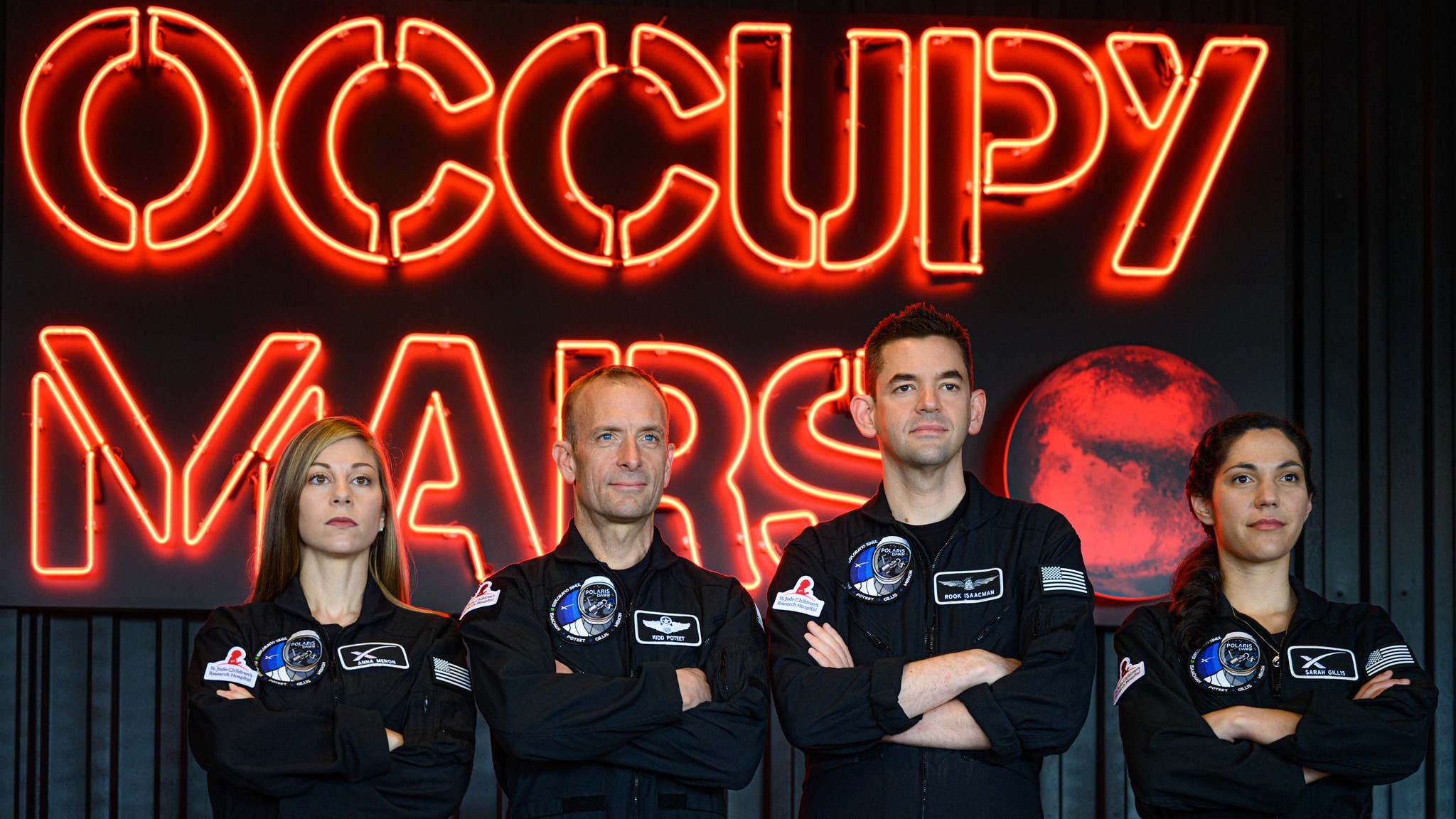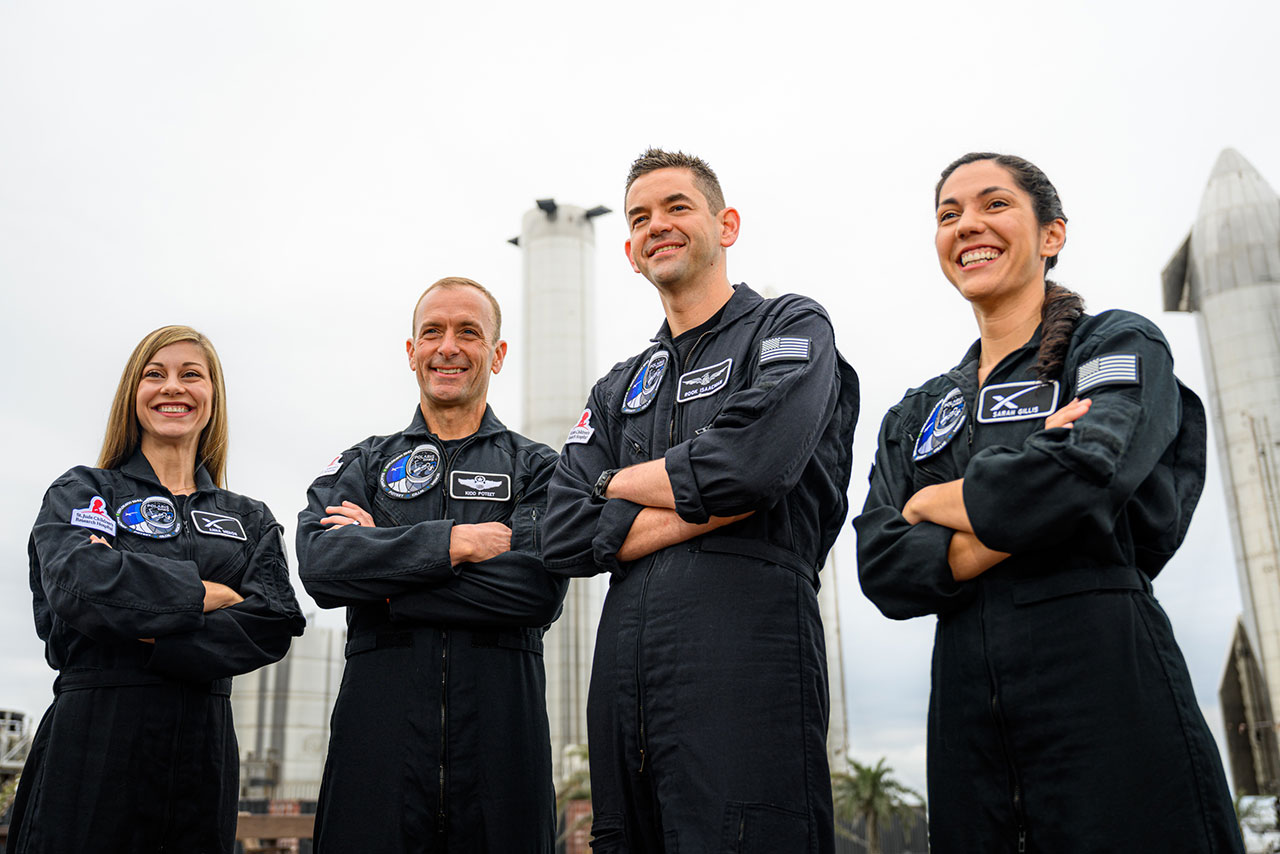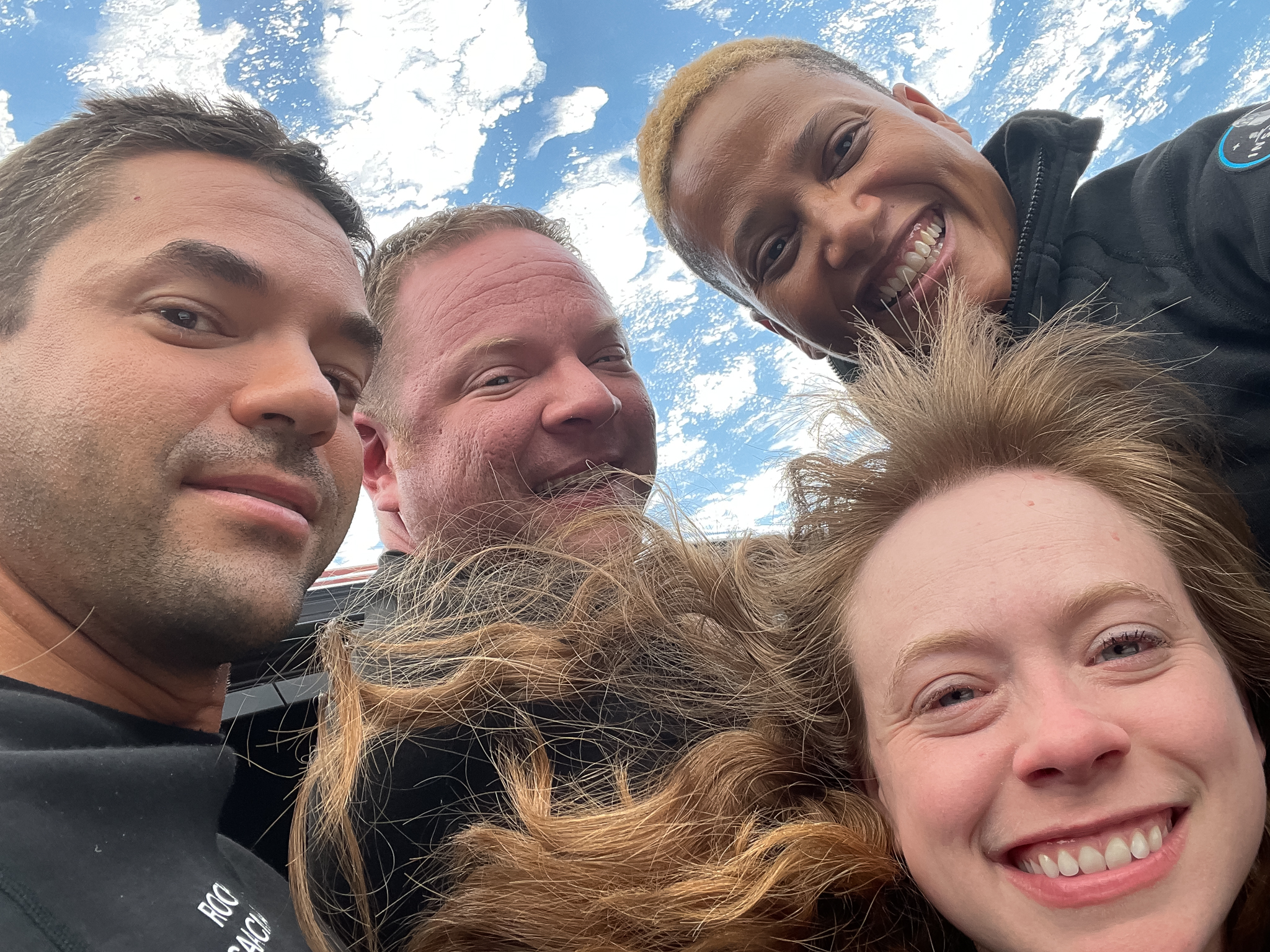
The Polaris Program is a planned series of three private crewed space missions led by U.S. billionaire Jared Isaacman.
The missions will utilize SpaceX technology, with the rockets, crewed spacecraft, and spacesuits all provided by SpaceX.
There are several purposes to each of the planned missions, including furthering research on human health in spaceflight, demonstrating SpaceX technology such as Starlink laser-based communications, and raising funds for charitable causes.
Related: NASA's Artemis program: Everything you need to know
The missions will attempt to set a number of space milestones including the highest crewed Earth orbit and the first-ever commercial spacewalk. It will also debut SpaceX's extravehicular spacesuit.
The program shares its name with Polaris, a constellation of three stars commonly known as the North Star since it appears as a single point of light to the naked eye.
Polaris Program missions
The Polaris Program will consist of three missions in total. They are as follows:
Polaris Dawn

Polaris Dawn was the first of the planned missions under the Polaris Program. It launched on Sept. 10, 2024
The mission involved a crew of four, launching in a SpaceX Crew Dragon capsule atop a Falcon 9 rocket. The crew then spent five days in Earth orbit, during which time they reached an altitude of 870 miles (1,400 kilometers) — higher than any previous SpaceX Dragon mission. Polaris Dawn also achieved the highest Earth orbit ever flown during a crewed mission — above the 853-mile (1,373 kilometers) crewed altitude record set by the Gemini 11 mission.
The Polaris Dawn crew also carried out the first commercial spacewalk using spacesuits designed by SpaceX.
The mission involved 38 research experiments that helped scientists understand more about how space travel affects the human body. Such experiments included the use of ultrasound to measure changes to eye structure in microgravity and determine how the body processes common pharmaceuticals in orbit. Since the crew passed through Earth's Van Allen radiation belt, Polaris Dawn also provided data on the impacts of space radiation on human health, which could be useful for future long-distance space missions.
The crew consisted of mission commander Jared Isaacman, pilot Scott Poteet, specialist Sarah Gills, and specialist and medical officer Anna Mennon.
Read more: SpaceX's private Polaris Dawn astronauts splash down to end historic spacewalk mission (video)
Mission II
As of August 2024, little is publicly known about the second planned Polaris Program mission, including its date, name, purpose, or launch vehicle.
According to the official Polaris Program website Mission II will build upon Polaris Dawn. "This mission will continue to expand the boundaries of future human spaceflight missions, in-space communications, and scientific research," the website states.
Mission III
Little is known about the third and last Polaris Program mission, except that the launch and crew vehicle is set to be SpaceX's Starship vehicle. If successful, Mission III will be the first crewed Starship flight.
Polaris Program FAQs answered by an expert
We asked Svetla Ben-Itzhak, assistant professor of space and international relations at Air University with the West Space Seminar, Air War College, Alabama, and Todd Leif Ericson, Polaris Dawn mission director a few questions about the Polaris Program.
Will private space missions like the Polaris Program change spaceflight, and how?
Ben-Itzhak: Yes, private commercial initiatives in space are already changing spaceflight in two important ways. First, they help to decrease the cost to access space. SpaceX, for instance, singlehandedly, decreased the cost of launch (of both humans and cargo) to space by focusing on reusability and use of COTS (commercial/consumer off-the-shelf) materials.
In the past, traditional, high-value satellites usually cost between $500 MLN [million] to $3+ BLNS [billion] each: today, the cost is in the tens of millions of dollars per satellite. More private citizens have been to space in the last ten years than in the previous fifty years. Second, private space missions have re-ignited the public's enthusiasm and interest in space and space exploration and have taken technological progress to new highs.
Private individuals — such as Elon Musk, Jared Isaacman, Jeff Bezos, Richard Branson and several more — are investing personal resources in spaceflight not because they seek a quick profit, which is quite impossible when dealing with space, but because they believe. They believe in the importance of space exploration, in investing in space research and development, in reaching for the stars literally and making humans interplanetary species.
What will the future hold for the Polaris Program and the private space industry?
Ericson: Polaris' missions are designed to build upon each other, demonstrating the skills and technologies required for us to not only return to the moon, but also those necessary when venturing onward to Mars and beyond. Polaris Dawn is the initial step along that road and will accomplish several firsts.
Dawn will break Gemini 11's record for the highest Earth orbit when it boosts into 1400+ km [870-mile] apogee. This will provide valuable data on the radiation environment well above the ISS's orbit of 420km and its impacts on modern electronic equipment. Dawn will also perform the first civilian Extra Vehicular Activity (EVA) using a bespoke suit designed, built and tested by SpaceX in just over a year's time and at a fraction of the cost of current EVA suits. Additionally, Dawn will add high-speed data capability to Dragon via the Starlink satellite network, significantly increasing the bandwidth available to spacecraft.
The second mission will be announced this spring with objectives that build upon the capabilities demonstrated on Polaris Dawn and the third mission will be the first human flight aboard SpaceX's Starship.
Ben-Itzhak: The future of the Polaris Program and the private space industry is very promising. Decreasing prices and a reignited public interest in space travel will provide a steady flow of customers, excited to participate in space tourism and to invest not only their money and time, but also [their] lives.
The private space industry has been experiencing steady growth over the last two decades. Just between 2005 to 2020, commercial space revenue more than tripled going from $110 BLN to $362 BLN in 2021 (according to the Space Foundation). Morgan Stanley projects that the global space economy will rocket to more than $1 trillion by 2040, with growth concentrated in the commercial space sector. 2021, in particular, was an incredible year for commercial human spaceflight. That year, it generated $425 million in revenue, more than seven times what was previously projected.
In 2021, Virgin Galactic and Blue Origin kicked off their commercial flight services with trips by their founders, Richard Branson and Jeff Bezos, respectively. Then, in April 2022, Space-X launched the Ax-1 mission for Axiom Space, which carried four private astronauts to the International Space Station for $55 million per seat. Axiom has contracted with SpaceX for the Ax-2, 3, and 4 missions expected to take place in coming years.
Why are the Polaris Program and missions like it important?
Ericson: Of the billions of men and women who have called Planet Earth home, up to this point in history, only a mere 628 have traveled outside our atmosphere.
The Polaris Program is important as it marks the beginning of what will be the 2nd Space Age, an era in which spaceflight leaves the exclusive domain of governments and becomes increasingly accessible by the civil world.
Polaris' first two missions aboard SpaceX's Falcon9/Dragon will set the foundation for the third mission, the first human flight aboard Starship. Starship, the first fully reusable orbital vehicle, will not only be capable of carrying up to 100 people into orbit at a fraction of current costs but it will also do so at a launch cadence an order of magnitude greater than what is currently possible today. Starship's low-cost, frequent and rapid access to space will begin to shrink our solar system in the same way the Douglas DC-3 began to shrink our world in the 1930's.
Ben-Itzhak: Such missions advance scientific and technical knowledge, inspire, and, thus, contribute to the bettering of humanity in both tangible and intangible ways.
Who is Jared Isaacman?

The Polaris Program is headed by Jared Isaacman, aircraft pilot and billionaire CEO of payment company Shift4. He also founded the military air service contractor Draken International.
In 2021, Isaacman made headlines with the Inspiration4 mission — the first orbital spaceflight with a crew made entirely of private citizens, including himself as mission commander. As with the Polaris Program, Isaacman developed the Inspiration4 mission plan in cooperation with SpaceX, which provided a Dragon capsule and Falcon 9 launch vehicle. The three-day low-Earth orbit mission was ultimately a success and raised over $240 million for St. Jude Children's Research Hospital in Memphis, Tennessee — a hospital that researches and provides treatment and cures for pediatric diseases including cancer.
Isaacman will serve again as mission commander for the Polaris Dawn mission. Outside of spaceflight, he has a claimed 7,000-plus flight hours of aviation experience.
Support to St. Jude Children's Research Hospital
Like the Inspiration4 mission that precedes it, the Polaris Program will provide support to St. Jude Children's Research Hospital.
"As little as we understand about the worlds beyond ours, there's so much we still don't understand about our bodies," said Isaacman after visiting the Inspiration4 Advanced Research Center at the hospital in 2022 — a facility which was funded in part by the mission it is named after. "Walking through the Inspiration4 Advanced Research Center really reinforced for me the importance of St. Jude and the mission and everything they're trying to accomplish."
St Jude Children’s Research Hospital is notable for having treated Inspiration4 crew member Hayley Arceneaux, a pediatric cancer survivor when she was a child. She later became a physician assistant at the hospital. With Inspiration4, Arceneaux became the first pediatric cancer survivor to go to space and the first astronaut with a prosthetic body part.
Additional resources
For another example of a prominent upcoming commercial space mission, see the dearMoon mission project which aims to send a nine-person civilian crew on a week-long journey around the moon and back using a SpaceX Starship rocket. To find out more about the economics behind the burgeoning commercial space industry, see this 2021 article from two Harvard Business School experts on the topic. To learn more about Jared Isaacman's previous mission with SpaceX — Inspiration4 — you may want to read crew member Hayley Arceneaux's 2022 memoir Wild Ride.
Bibliography
Polaris Program website [Accessed 2/8/23] https://polarisprogram.com/
'Polaris Dawn takes St. Jude back to space, boosting efforts to save more children worldwide', stjude.org [Accessed 2/8/23] https://www.stjude.org/inspire/series/selfless/polaris-dawn-jared-isaacman-stjude-space-fundraiser.html
'Polaris Dawn Selects 38 Science and Research Experiments to Advance Human Health and Space Exploration', newswire.ca [Accessed 2/8/23] https://www.newswire.ca/news-releases/polaris-dawn-selects-38-science-and-research-experiments-to-advance-human-health-and-space-exploration-837277727.html
'SpaceX training begins this month for first commercial spacewalk mission', Spaceflightnow.com [Accessed 2/9/23] https://spaceflightnow.com/2022/05/10/spacex-training-begins-this-month-for-first-commercial-spacewalk-mission/
'55 Years Ago: Gemini XI Achieves One-Orbit Rendezvous, Record Altitude', Nasa.gov [Accessed 2/9/23] https://www.nasa.gov/feature/55-years-ago-gemini-xi-achieves-one-orbit-rendezvous-record-altitude







